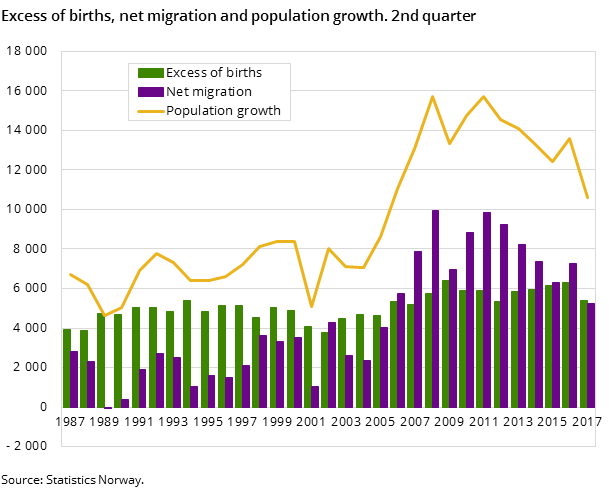Low population growth
Published:
Low figures for immigrations and births resulted in a low growth in the population in the second quarter. The low growth in the size of the population seen over the two past years continues.
- Full set of figures
- Population
- Series archive
- Population (archive)
The population grew by 10 600 people to at total of 5 278 000 on 1 July 2017, according to new figures from the statistics Population and population changes. This is the lowest population growth in the 2nd quarter since the high labour influx started in 2006 following the EU expansion in Eastern Europe.
About 12 400 persons were registered as immigrated and 15 100 children were born in the 2nd quarter. At the same time, 7 200 persons emigrated and 9 700 persons died. This resulted in a net migration of 5 200 people and an excess of births of 5 400. The excess of births is the lowest in any 2nd quarter since 2007. Nevertheless, the birth surplus in the last quarter contributed more to population growth than the net immigration. This has not happened in any quarter since the period of high immigration started in 2006. The reason for this is that net immigration dropped much more than the birth surplus.
Four counties had no population growth
Apart from a slight decline or an almost status quo in Oppland, Sogn and Fjordane, Troms and Finnmark, all other counties had a population growth. All counties had net immigration from abroad, but a somewhat higher domestic migration loss led to five counties, including Oslo, having a net migration loss. A large birth surplus in Oslo offset this, and consequently the population of Oslo increased by 240 people. The highest population growth was in Akershus, Rogaland and Østfold with 3 840, 1 020 and 990 more residents in the 2nd quarter. All counties apart from Hedmark and Oppland had birth surpluses.
Figure 2. Excess of births and net migration. 2nd quarter 2017
| Excess of births | Net migration | |
| Finnmark Finnmárku | 0.1 | -0.1 |
| Troms Romsa | 0.5 | -0.7 |
| Nordland | 0.4 | 0.5 |
| Nord-Trøndelag | 0.4 | 1.4 |
| Sør-Trøndelag | 1.2 | -1.0 |
| Møre og Romsdal | 0.9 | 1.0 |
| Sogn og Fjordane | 0.5 | -0.6 |
| Hordaland | 1.2 | 0.4 |
| Rogaland | 1.8 | 0.4 |
| Vest-Agder | 1.2 | 1.0 |
| Aust-Agder | 0.4 | 2.1 |
| Telemark | 0.1 | 1.4 |
| Vestfold | 0.4 | 2.9 |
| Buskerud | 0.8 | 1.7 |
| Oppland | -0.2 | 0.1 |
| Hedmark | -0.3 | 1.7 |
| Oslo | 2.4 | -2.1 |
| Akershus | 1.3 | 5.0 |
| Østfold | 0.4 | 3.0 |
| The whole country | 1.0 | 1.0 |
Lower immigration
In recent years, the net immigration of Eastern European citizens, who mostly have immigrated because of work, has subsided, while immigration from countries with conflicts has increased. We are now also seeing a decline in immigration from countries with conflicts. Comparisons with figures from the 2nd quarter of 2016 show that net immigration from Syria and Eritrea has roughly halved. Net immigration from countries such as Afghanistan, Sudan and Somalia is also decreasing. From countries in Eastern Europe, net immigration continues to decline, while the trend of more Swedish nationals leaving than entering Norway continues.
Figure 3. Net migration by citizenship. Selected countries. 2nd quarter
| 2013 | 2014 | 2015 | 2016 | 2017 | |
| Syria | 161 | 350 | 656 | 2926 | 1664 |
| Eritrea | 467 | 470 | 908 | 1102 | 495 |
| Afghanistan | 191 | 127 | 434 | 368 | 271 |
| Poland | 1459 | 1440 | 880 | 624 | 378 |
| Lithuania | 784 | 679 | 327 | 198 | 263 |
| Sweden | -18 | -78 | -161 | -271 | -293 |
In the second quarter, 1 940 Norwegian citizens emigrated, while 1 943 immigrated.
Contact
-
Anders Falnes-Dalheim
-
Kirsten Dybendal
-
Laila Holmen Lystad
-
Oppdrag befolkningsstatistikk
-
Statistics Norway's Information Centre

